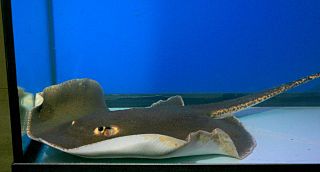
The roughback whipray is a rare species of freshwater stingray in the family Dasyatidae, found over sandy bottoms in the Mae Klong and Chao Phraya Rivers of Thailand. Growing no more than 29 cm (11 in) across, this small ray has an oval pectoral fin disc and a whip-like tail without fin folds. It closely resembles the white-edge freshwater whipray in appearance, but can be distinguished by its coloration: light gray to dark orange-brown above and white below with a dark band along the lateral margins. Another identifying feature is a "pearl organ" at the center of the back, found in individuals of all ages. All of the original specimens of the roughback whipray were found with extensive wounds to the fins and tail. The International Union for Conservation of Nature (IUCN) has assessed this species as Endangered, citing the extensive habitat degradation and heavy fishing pressure within its limited range.

The decoy scorpionfish is a species of marine ray-finned fish belonging to the family Scorpaenidae, the scorpionfishes. It is native to the Western Indian and Pacific oceans. A non-migratory species, I. signifer can be observed in close association with coral reefs at depths of from 10 to 70 metres. This species grows to a length of 13 centimetres (5.1 in) TL. This species is the only known member of its genus and can be distinguished by its unique prey-luring behavior.

The chocolate wattled bat is a bat in the family Vespertilionidae. It is found only in Australia, including the island Tasmania, and widespread in southern regions. It is known to reside from sea level to at least 1,570 metres (5,150 ft) in Victoria.
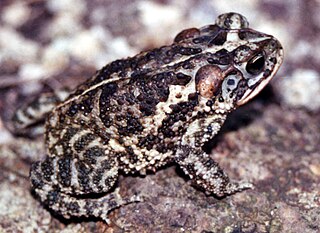
Incilius coccifer is a species of toad in the family Bufonidae. It is found in southern Mexico and southeastward in the Central America through Guatemala, El Salvador, Honduras, and Nicaragua to northwestern Costa Rica. Several species that were formerly included in this species have been named as distinct species: Incilius porteri, Incilius ibarrai, Incilius pisinnus, and Incilius signifer. Its natural habitats are lowland dry and moist forests, and it occurs also in disturbed areas such as pastures, roadside ditches, gardens, and vacant lots in urban areas. It is an abundant and widespread species that is not facing significant threats.

Incilius ibarrai is a species of toad in the family Bufonidae. It is found in the central and southern highlands of Guatemala and adjacent Honduras. The specific name ibarrai honors Jorge Alfonso Ibarra (1921–2000), then-director of the Guatemalan National Natural History Museum.
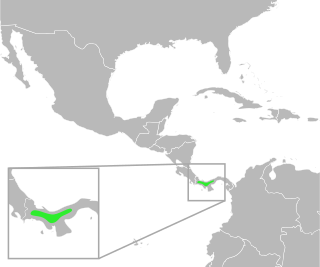
Incilius signifer is a species of toads in the family Bufonidae. It is endemic to Panama and known from the Pacific Coast to 800 m (2,600 ft) asl, west of the Canal Zone. Prior to its description in 2005, it was mixed with Incilius coccifer. Its natural habitats are tropical dry forests. It tolerates habitat modification but could be threatened by severe habitat modification.
Pristimantis signifer is a species of frog in the family Strabomantidae.
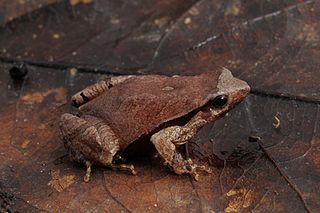
Physalaemus signifer is a species of frog in the family Leptodactylidae. It is endemic to Brazil. Its natural habitats are subtropical or tropical moist lowland forests, dry savanna, freshwater marshes, and intermittent freshwater marshes. It is threatened by habitat loss.
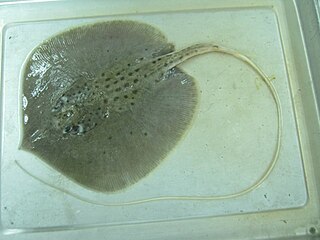
The white-edge freshwater whipray is an extremely rare species of stingray in the family Dasyatidae, native to four river systems in Southeast Asia. Measuring up to 60 cm (24 in) across, this ray has an oval pectoral fin disc and a very long, whip-like tail without fin folds. It can be identified by the presence of a sharply delineated white band running around the margin of its otherwise brown disc, as well as by its white tail and a band of dermal denticles along the middle of its back. This species feeds on benthic invertebrates and is aplacental viviparous. Its two long tail spines are potentially dangerous to humans. The International Union for Conservation of Nature (IUCN) has assessed the white-edge freshwater whipray as Endangered, as it is under heavy pressure from fishing and habitat loss, degradation, and fragmentation.
The honey blue-eye is an endangered species of fish in the subfamily Pseudomugilinae. It is endemic to southeastern Queensland, Australia, where it is found in mildly acidic, often tannin-stained, ponds and streams in wallum habitat.

Endoclita signifer is a species of moth of the family Hepialidae. It is found in eastern Asia, including Japan, Taiwan, Sylhet, Burma, Borneo and Java.
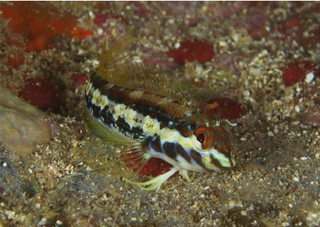
Emblemariopsis signifer is a species of chaenopsid blenny found in coral reefs in the western Atlantic ocean. It can reach a maximum length of 2.8 centimetres (1.1 in) SL. This species is preyed on by Horse-eye jacks.

The Pacific blue-eye is a species of fish in the subfamily Pseudomugilinae native to eastern Australia. Described by Austrian naturalist Rudolf Kner in 1866, it comprises two subspecies that have been regarded as separate species in the past and may be once again with further study. It is a common fish of rivers and estuaries along the eastern seaboard from Cape York in North Queensland to southern New South Wales, the Burdekin Gap in central-north Queensland dividing the ranges of the two subspecies.
Apobaetis signifer is a species of small minnow mayfly in the family Baetidae.
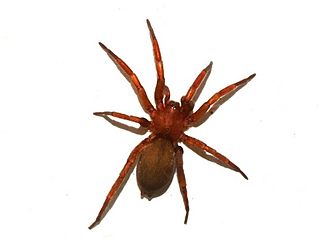
Haplodrassus signifer is a species of ground spider in the family Gnaphosidae. It is found in North America, Europe, Turkey, Israel, Caucasus, a range from Russia to Central Asia, China, and Korea.

Epalpus signifer is a species of bristle fly in the family Tachinidae. It is found in North America.
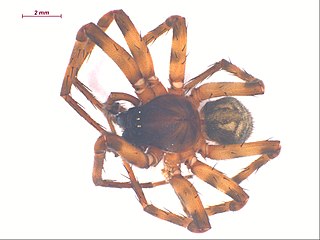
Cybaeus signifer is a species of true spider in the family Cybaeidae. It is found in the United States and Canada.
Liolaemus signifer, the zodiac tree iguana, is a species of lizard in the family Liolaemidae. It is native to Chile, Bolivia, and Peru.














